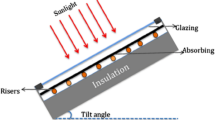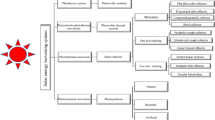Abstract
The present work aims to investigate thermal performance of a solar flat plate collector using water and Cu-MWCNTs nanoparticle-based hybrid nanofluid both experimentally and numerically. X-ray diffraction and FESEM with EDAX mapping were performed to characterize nanoparticles. The experimental setup was developed for thermal performance of FPC varying flow rates (0.5, 1.0, 1.5 LPM), inclination angle (25°, 30°, 35°, 40°, 45°), volume concentration (0%, 0.1%, 0.2%, 0.3%, 0.4%), and intensity (400 W/m2). The 3D numerical model having similar geometry as of actual flat plate collector was modeled using Fluents 15.0. The SST turbulence model was used to capture the chaotic changes in the velocity, temperature, and pressure fields. The experimental findings revealed 79.74% improvement in instantaneous efficiency at 0.4% vol., 1.5 LPM, 45° inclination angle, and 400 W/m2 intensity. The maximum deviation between the experimental and numerically calculated outlet and inlet temperature difference (ΔT) was 3.5% using a hybrid nanofluid. When numerical data are compared, instantaneous efficiency and heat gain both deviate by 2.8% and 2.9% from experimental values. Because of the numerical simulation analysis, it is possible to observe the temperature and flow pattern in flat plate collectors using nanofluids under a set of operating conditions, which would not be possible without the simulation.


















Similar content being viewed by others
Data availability
As per on request basis.
Abbreviations
- FPC:
-
Flat plate collector
- EDAX:
-
Energy-dispersive X-ray analysis
- FESEM:
-
Field emission scanning electron microscope
- LPM:
-
Liter per minute
- MWCNT:
-
Multi-wall carbon nanotubes
- XRD:
-
X-ray diffraction
- CFD:
-
Computational fluid dynamics
- A c :
-
Area of collector
- Cp :
-
Specific heat capacity of working fluid (J/kg k)
- F R :
-
Heat removal factor
- I t :
-
Instantaneous intensity of radiation
- Q i :
-
Incident energy on solar collector
- Q u :
-
Useful heat gain of working fluid
- R 2 :
-
Correlation coefficient
- T ab :
-
Ambient temperature
- T in :
-
Inlet temperature of working fluid
- T out :
-
Outlet temperature of working fluid
- V :
-
Volume flow rate
- I :
-
Intensity of radiation
- T :
-
Temperature
- K :
-
Thermal conductivity
- m :
-
Mass flow rate
- R :
-
Coefficient of determination
- ρ :
-
Density
- β :
-
Inclination angle
- η :
-
Instantaneous efficiency
- η FPC :
-
Efficiency of FPC
- η Siu . :
-
Correlation efficiency
- η exp . :
-
Experimental efficiency
- μ :
-
Viscosity
References
Al-Shamani AN et al (2014) Nanofluids for improved efficiency in cooling solar collectors–a review. Renew Sustain Energy Rev 38:348–367
AlSaidi RA et al (2022) Insight into electronic structure and optical properties of ZnTPP thin films for energy conversion applications: experimental and computational study. Mater Today Commun 32:103874
Ashour AF, El-Awady AT, Tawfik MA (2022) Numerical investigation on the thermal performance of a flat plate solar collector using ZnO & CuO water nanofluids under Egyptian weathering conditions. Energy 240:122743
Azimy H, Azimy N, Meghdadi Isfahani AH, Bagherzadeh SA, Farahnakian M (2022) Analysis of thermal performance and ultrasonic wave power variation on heat transfer of heat exchanger in the presence of nanofluid using the artificial neural network: experimental study and model fitting. J Therm Anal Calorim. https://doi.org/10.1007/s10973-022-11827-1
Azimy N, Saffarian MR (2023) Investigation of thermal characteristics and entropy generation in a solar collector including fly ash-Cu hybrid nanofluids: numerical approach using mixture model. Eng Anal Boundary Elem 152:169–184
Azimy N, Saffarian MR, Noghrehabadi A (2022) Thermal performance analysis of a flat-plate solar heater with zigzag-shaped pipe using fly ash-Cu hybrid nanofluid: CFD approach. Environ Sci Pollut Res. https://doi.org/10.1007/s11356-022-24640-y
Bhatt M et al (2011) Experimental investigations on top loss coefficients of solar flat plate collector at different tilt angle. World Acad Sci Eng Technol 79:432–436
Bianco V et al (2010) Numerical simulation of water/Al2O3 nanofluid turbulent convection. Adv Mech Eng 2:976254
Cao Y et al (2022a) Hydrogen production using solar energy and injection into a solid oxide fuel cell for CO2 emission reduction; thermoeconomic assessment and tri-objective optimization. Sustain Energy Technol 50:101767
Cao Y et al (2022b) Comprehensive thermodynamic and economic analyses and optimization of a novel poly-generation setup utilizing solar and geothermal sources. Appl Therm Eng 207:118133
Choi SU, Eastman JA (1995) Enhancing thermal conductivity of fluids with nanoparticles, Argonne National Lab.(ANL), Argonne, IL (United States)
Darbari B, Rashidi S (2021) Thermal efficiency of flat plate thermosyphon solar water heater with nanofluids. J Taiwan Inst Chem Eng 128:276–287
Dong S et al (2022) Investigation of thermal performance of a shell and tube latent heat thermal energy storage tank in the presence of different nano-enhanced PCMs. Case Stud Therm Eng 37:102280
Eastman JA et al (2001) Anomalously increased effective thermal conductivities of ethylene glycol-based nanofluids containing copper nanoparticles. Appl Phys Lett 78(6):718–720
Elsheikh A et al (2018) Applications of nanofluids in solar energy: a review of recent advances. Renew Sustain Energy Rev 82:3483–3502
Fan L et al (2022) Experimental and numerical investigation on the accuracy of phosphor particle streak velocimetry. Exp Fluids 63(10):165
Gupta SK, Pradhan S (2021) A review of recent advances and the role of nanofluid in solar photovoltaic thermal (PV/T) system. MaterToday: Proceedings 44:782–791
Israelachvili JN (2011) Intermolecular and Surface Forces, 3rd edn. Academic Press. San Diego
Jones WP, Launder BE (1972) The prediction of laminarization with a two-equation model of turbulence. Int J Heat Mass Transfer 15(2):301–314
Kalogirou S (2003) The potential of solar industrial process heat applications. Appl Energy 76(4):337–361
Kumar KH et al (2022a) Solar parabolic dish collector for concentrated solar thermal systems: a review and recommendations. Environ Sci Pollut Res 29(22):32335–32367
Kumar R et al (2022b) Performance evaluation of cerium oxide/water nanofluid based FPSC: an experimental analysis. Mater Today: Proceedings 56:1659–1667
Kundu PK, Cohen IM, Dowling D (2008) Fluid mechanics, 4th edn. Elsevier
Moravej M et al (2020) Experimental investigation of circular flat-panel collector performance with spiral pipes. J Therm Anal Calorim 140:1229–1236
Moraveji MK, Ardehali RM (2013) CFD modeling (comparing single and two-phase approaches) on thermal performance of Al2O3/water nanofluid in mini-channel heat sink. Int Commun Heat Mass Transfer 44:157–164
Mustafa J et al (2023) Numerical study of two-phase turbulence nanofluid flow in a circular heatsink for cooling LEDs by changing their location and dimensions. Eng Anal Boundary Elem 149:248–260
Mustafa J et al (2022) Evaluation of energy efficiency, visualized energy, and production of environmental pollutants of a solar flat plate collector containing hybrid nanofluid. Sustain Energy Technol Assess 53:102399
Otanicar TP, Golden JS (2009) Comparative environmental and economic analysis of conventional and nanofluid solar hot water technologies. Environ Sci Technol 43(15):6082–6087
Qu J et al (2019) Photo-thermal conversion properties of hybrid CuO-MWCNT/H2O nanofluids for direct solar thermal energy harvest. Appl Therm Eng 147:390–398
Ranjith P, Karim AA (2016) A comparative study on the experimental and computational analysis of solar flat plate collector using an alternate working fluid. Procedia Technol 24:546–553
Sadeghi M et al (2020) Full-field analysis of gas flow within open-cell foams: comparison of micro-computed tomography-based CFD simulations with experimental magnetic resonance flow mapping data. Exp Fluids 61(5):1–16
Saffarian MR et al (2020) Heat transfer enhancement in a flat plate solar collector with different flow path shapes using nanofluid. Renewable Energy 146:2316–2329
Shamsul Azha NI et al (2020) Thermal performance enhancement in flat plate solar collector solar water heater: a review. Processes 8(7):756
Sharafeldin MA et al (2017) Experimental study on the performance of a flat-plate collector using WO3/Water nanofluids. Energy 141:2436–2444
Sharma A et al (2022) Conductive and convective heat transfer augmentation in flat plate solar collector from energy, economic and environmental perspectives—a comprehensive review. Environ Sci Pollut Res: 1–49
Singh R et al (2019) An experimental investigation of thermal conductivity of TiO2 nanofluid: proposing a new correlation. J Sci Ind Res (JSIR) 78(9):620–623
Singh RP (2023) An experimental study to develop a new correlation of the heat conductivity of CeO2 nanofluid. Materials Today: Proceedings
Singh S, Ghosh SK (2022) Pressure drop and heat transfer characteristics in 60° Chevron plate heat exchanger using Al2O3, GNP and MWCNT nanofluids. Int J Numer Methods Heat Fluid Flow 32(8):2750–2777
Singh S, Kumar S, Ghosh SK (2021) Development of a unique multi-layer perceptron neural architecture and mathematical model for predicting thermal conductivity of distilled water based nanofluids using experimental data. Colloids Surf A: Physicochem Eng Asp 627:127184
Singh S et al (2021b) Numerical and experimental analysis of performance in a compact plate heat exchanger using graphene oxide/water nanofluid. Int J Numer Methods Heat Fluid Flow
Sint NKC et al (2017) Theoretical analysis to determine the efficiency of a CuO-water nanofluid based-flat plate solar collector for domestic solar water heating system in Myanmar. Sol Energy 155:608–619
Tavakoli M, Soufivand MR (2023) Investigation of entropy generation, PEC, and efficiency of parabolic solar collector containing water/Al2O3− MWCNT hybrid nanofluid in the presence of finned and perforated twisted tape turbulators using a two-phase flow scheme. Eng Anal Boundary Elem 148:324–335
Tian Y, Zhao C-Y (2013) A review of solar collectors and thermal energy storage in solar thermal applications. Appl Energy 104:538–553
Tong Y et al (2019) Energy and exergy comparison of a flat-plate solar collector using water, Al2O3 nanofluid, and CuO nanofluid. Appl Therm Eng 159:113959
Unar IN et al (2022) Modeling and simulation of solar flat plate collector for energy recovery at varying regional coordinates. Environ Sci Pollut Res 29(3):4748–4761
Verma SK, Tiwari AK (2015) Progress of nanofluid application in solar collectors: a review. Energy Convers Manag 100:324–346
Verma SK et al (2017a) Experimental evaluation of flat plate solar collector using nanofluids. Energy Convers Manag 134:103–115
Verma SK, Tiwari AK, Chauhan DS (2017) Experimental evaluation of flat plate solar collector using nanofluids. Energy Convers Manag 134:103–115
Verma SK et al (2018) Performance analysis of hybrid nanofluids in flat plate solar collector as an advanced working fluid. Sol Energy 167:231–241
Vital CV et al (2021) Numerical assessment of transition metal nitrides nanofluids for improved performance of direct absorption solar collectors. Appl Therm Eng 190:116799
Zhou L et al (2019) CFD investigation of a new flat plate collector with additional front side transparent insulation for use in cold regions. Renewable Energy 138:754–763
Author information
Authors and Affiliations
Contributions
Conception and design of the study: Shiva Singh, Kuwar Mausam, Subrata Kumar Ghosh, A.K.Twari; acquisition of data: Kuwar Mausam, Shiva Singh; analysis and/or interpretation of data: Shiva Singh, Kuwar Mausam, Subrata Kumar Ghosh; drafting the manuscript: Shiva Singh; Kuwar Mausam; revising the manuscript critically for important intellectual content: Subrata Kumar Ghosh, A.K.Twari; approval of the version of the manuscript to be published: Shiva Singh, Kuwar Mausam, Subrata Kumar Ghosh, Arun Kumar Tiwari.
Corresponding author
Ethics declarations
Ethics approval
Not applicable.
Consent to participate
Not applicable.
Consent for publication
Not applicable.
Competing interests
The authors declare no competing interests.
Additional information
Responsible Editor: Philippe Garrigues
Publisher's note
Springer Nature remains neutral with regard to jurisdictional claims in published maps and institutional affiliations.
Rights and permissions
Springer Nature or its licensor (e.g. a society or other partner) holds exclusive rights to this article under a publishing agreement with the author(s) or other rightsholder(s); author self-archiving of the accepted manuscript version of this article is solely governed by the terms of such publishing agreement and applicable law.
About this article
Cite this article
Singh, S., Mausam, K., Ghosh, S.K. et al. An experimental and numerical approach for thermal performance investigation of solar flat plate collector. Environ Sci Pollut Res 30, 92859–92879 (2023). https://doi.org/10.1007/s11356-023-28843-9
Received:
Accepted:
Published:
Issue Date:
DOI: https://doi.org/10.1007/s11356-023-28843-9




